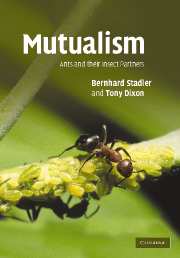3 - Theories on mutualism
Published online by Cambridge University Press: 13 August 2009
Summary
Theories on co-operation
The theory of co-operation between kin and closely related individuals has flourished since the publication of Hamilton's C/B < r rule, stating that the relatedness (r) of an individual that profits from a co-operative (altruistic) act must be higher than the cost (C)/benefit (B) ratio this act imposes. This inclusive fitness concept is best explained by a simple example. Consider a pair of diploid brothers (r = 0.5) who share, on average, 50% of their genes. If one of them sacrifices his own fitness by not reproducing (C = 1) but helps his brother to rear his offspring successfully the following condition must be fulfilled. In order for C/B to become smaller than r the benefit for the receiver of the altruistic act must at least double before the altruist will gain representation in the next generation. Evidently, to beat the disadvantage of not reproducing when a high coefficient of relatedness is involved, low costs or large benefits are needed. As the benefit of co-operation decreases rapidly with declining relatedness, it becomes clear that the ability to discriminate between related and unrelated individuals is vital for the evolution of co-operation. Given that ants and partners of ants like aphids, lycaenids or coccids are often socially organized, relatedness is an important issue also in the co-operation between members of different species (mutualism). Therefore, it might be helpful to briefly explore the major theories and mechanisms involving co-operation/mutualism trajectories (Table 3.1).
- Type
- Chapter
- Information
- MutualismAnts and their Insect Partners, pp. 14 - 56Publisher: Cambridge University PressPrint publication year: 2008



